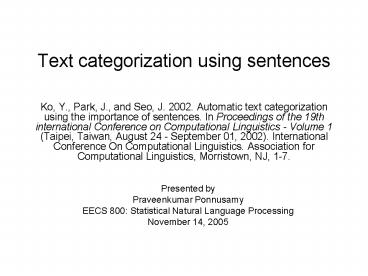Text categorization using sentences PowerPoint PPT Presentation
1 / 24
Title: Text categorization using sentences
1
Text categorization using sentences
- Ko, Y., Park, J., and Seo, J. 2002. Automatic
text categorization using the importance of
sentences. In Proceedings of the 19th
international Conference on Computational
Linguistics - Volume 1 (Taipei, Taiwan, August 24
- September 01, 2002). International Conference
On Computational Linguistics. Association for
Computational Linguistics, Morristown, NJ, 1-7.
Presented by Praveenkumar Ponnusamy EECS 800
Statistical Natural Language Processing November
14, 2005
2
Text categorization using sentences
- Introduction
- Proposed system
- Evaluation
- Results
- Summary
3
Introduction
- Assign text documents to predefined categories
based on their content - Application areas classifying news, email,
newsgroup, chat - Training phase feature extraction and indexing
- Classification algorithms Naïve Bayes, Rocchio,
k-Nearest Neighbor, Support Vector Machines
4
Introduction
- Vector space model using TF and IDF not adequate
- Each sentence has different importance to
identify the topic - Better results possible by assigning term weights
based on the importance of sentences
5
Proposed system
- Two kinds of summarization techniques for
identifying important and unimportant sentences - Similarity between title and sentences
- Importance of terms in each sentence
- Importance of sentences derived
- Term weights in each sentence modified in
proportion to the sentence importance - English and Korean newsgroup data sets used
6
Proposed system
- Preprocessing
- Contents Subject and body used
- Contents segmented into sentences
- Content words POS tagging
- English - Brill tagger
- Korean - Sogang tagger
- Sentences vector of content words
- TF values as term weights of content words
7
Proposed system
- Importance of sentences by title
- Title summarizes the important content
- Sentences similar to the title contain important
terms - Title and sentences as vector of content words
- Similarity calculated by inner product of
sentence and title vectors - Quality of the title
8
Proposed system
- Sentence importance by Term importance
- Sentences dissimilar to the title but with
important terms are important - Sentence importance importance of terms in it.
- Importance of terms TF, IDF, chi-square values
- Final score
9
Proposed system
- Indexing
- TF value of a term calculated using the final
importance score. - Modified TF value of term t in document d
- Weight of a term t in document d
10
Evaluation Data Sets
- English UseNet
- 20,000 articles
- 20 UseNet groups
- 4,000 docs (20) for test data
- 16,000 docs (80) for training data
- Vocabulary 51,018 words
- Korean UseNet
- 10,331 documents
- 15 categories
- 3,107 docs (30) for test data
- 7,224 docs (70) for training data
- Vocabulary 69,793 words
11
Evaluation
- Basis system used TF
- Proposed system used WTF
- Performance measures
- Recall, Precision
- F1 measure
- Micro-averaging method
- Macro-averaging method
12
Evaluation
- Setting the number of features
- Validation set from training data used
- Performance curve using SVM shown here k1k21
13
Evaluation
- For SVM, number of features is set to 7,000 based
on performance and running time. - Similarly for other classifiers
- Naïve Bayes 7,000
- Rocchio 10,000
- k-NN 9,000
14
Evaluation
- Setting the constant weights k1 and k2- range
0.0 to 3.0 - Compared Sim(S,T), Cen(S) and the combination
method - For combination method, k1k2
- Performance curve using SVM is shown features
7,000
15
Evaluation
- Best performance for
- SVM at k11.5 and k20.4
- Naïve Bayes at k11.9 and k23.0
- Rocchio at k12.0 and k20.0
- k-NN at k10.8 and k22.8
16
Results
- English newsgroup data set
17
Results
- Korean newsgroup data set
18
Results
- A collection of small tightly clustered documents
with wide separation between the clusters should
produce the best performance (Salton et al.,
1975) - Cohesion within a category similarity between
documents in same category - Cohesion between categories measure of
similarity between categories - High cohesion within a category and low cohesion
between categories.
19
Results
- D total training document set
- Ik training document set in k-th category
- Ck centroid vector of k-th category
- Cglob centroid vector of the total training
documents
20
Results
21
Results
22
Results
- Cen(S) had the highest cohesion value within a
category - Sim(S,T) showed the lowest cohesion value between
the categories
23
Results
- Cohesion values, within and between the
categories, for the combination method showed
middle values between the Cen(S) and Sim(S,T)
curves - The proposed indexing method reformed the vector
space for better performance
24
Summary
- New indexing method using two summarization
techniques - Data sets from two languages
- Four different classifiers
- Better performance
- Verified by cohesion analysis
- Try on newspapers and other types of documents
- Use more structural information in the document.

